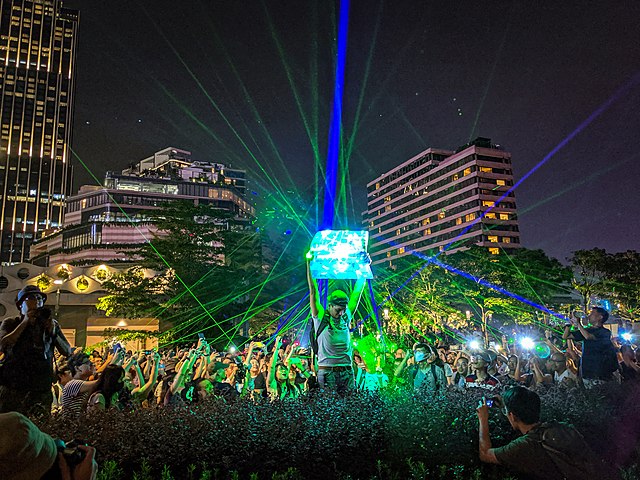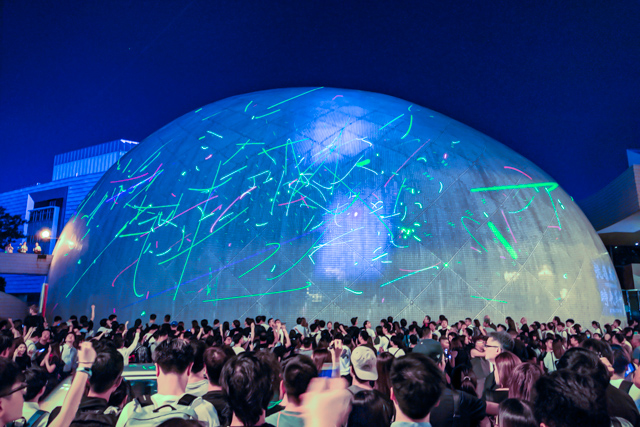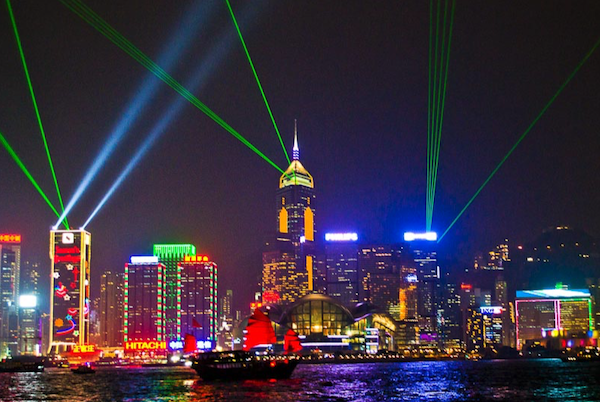Home
A comprehensive resource for safe and responsible laser use
Hong Kong: Conviction upheld based on laser pointer being an offensive weapon
In November 2019 the unnamed teenager was the first protester to be found guilty of carrying a laser pointer as an offensive weapon. He was sentenced to a rehabilitation center for three months.
During his May 2020 appeal, defense counsel said the laser pointer could have been used peacefully to point at buildings and draw attention. Counsel further said there was no evidence the teen had used the pointer, and that he had been cooperative with police.
However, the appeals judge agreed with prosecutors at the November 2019 trial. They said the teen was wearing protest gear including a helmet and he must have intended to use it to inflict harm or discomfort upon others. The judge also noted the teen did not present evidence or testify to contradict the prosecutors' claims.
The judge also said that using laser pointers on buildings for peaceful protest was "a fanciful notion".
A government expert testified that the laser device could cause harm if it were pointed at the human eye within a distance of 36 meters (118 feet).
From the South China Morning Post
COMMENTARY FROM LASERPOINTERSAFETY.COM
The 36 meter "ocular damage" distance probably refers to the laser's Nominal Ocular Hazard Distance. For a handheld laser with a typical beam of 1 milliradian beam spread, this corresponds to a laser of roughly 25 milliwatts. (The laser color would not be a factor in injury, only the power and divergence.)
In many countries the legal limit for a laser pointer is 1 mW; in the U.S. pointers of up to 5 mW are allowed to be sold.
A NOHD of 36 meters does not mean that injury will occur at that distance. As explained elsewhere, there is a safety or reduction factor built into the NOHD. At around 12 meters (39 feet), a 25 mW 1 mrad beam with a nominal 1/4 second exposure could cause the smallest detectable change in the retina about half the time, under laboratory conditions. Beyond 12 meters the chance of injury becomes even less until at the 36 meter NOHD it is considered an allowable exposure.
A one-quarter second exposure is used in the laser safety field for cases of accidental or unwanted beams. A person will blink, move or otherwise avoid eye exposure the laser light within that time.
Hong Kong: 100 hours community service for shining lasers at police
Kwok Fu-wah was said to have aimed the lasers "out of impulse". The incident interfered with police duties but there were no injuries reported.
He was originally charged with possessing offensive weapons in a public place which is punishable by imprisonment. However, prosecutors allowed him to plead guilty to "a diminished charge of similar nature" resulting in the lesser sentence of community service. The principal magistrate noted Kwok had a good background and was sorry for his actions.
His two laser pointers were examined by police, who said the "two devices could cause ocular damage if the eyes were directly exposed to the laser beam within 60 meters [200 feet]."
From the South China Morning Post
COMMENTARY FROM LASERPOINTERSAFETY.COM
The 60 meter "ocular damage" distance probably refers to the laser's Nominal Ocular Hazard Distance. For a handheld laser with a typical beam of 1 milliradian beam spread, this corresponds to a laser of roughly 70 milliwatts. (The laser color would not be a factor in injury, only the power and divergence.)
In many countries the legal limit for a laser pointer is 1 mW; in the U.S. pointers of up to 5 mW are allowed to be sold.
A NOHD of 60 meters does not mean that injury will occur at that distance. As explained elsewhere, there is a safety or reduction factor built into the NOHD. At around 20 meters (66 feet), a 70 mW 1 mrad beam with a nominal 1/4 second exposure could cause the smallest detectable change in the retina about half the time, under laboratory conditions. Beyond 20 meters the chance of injury becomes even less until at the 60 meter NOHD it is considered an allowable exposure.
A one-quarter second exposure is used in the laser safety field for cases of accidental or unwanted beams. A person will blink, move or otherwise avoid eye exposure the laser light within that time.
The distance from Kwok to the police officers was not stated in the article.
Hong Kong: Man acquitted on charge of posessing laser pointer weapon during protests
Ng Kai-nam testified he picked up four hitchhikers going to a demonstration. He told them to leave their bags in the car, and that he did not realize there were items defined as weapons in the bags.
The acting principal magistrate ruled that Ng knew the protesters had prohibited weapons, but found him not guilty since prosecutors were unable to prove if he knew the nature of the weapons.
From the South China Morning Post
Hong Kong, China: UPDATED - Widespread use of laser pointers during protests
Protests against increased Chinese control of Hong Kong began in March and April 2019. On June 21, lasers were aimed at police officers' eyes.
The use of lasers increased dramatically after the August 6 2019, arrest of 20-year-old Hong Kong Baptist University student union president Keith Fong for having 10 laser pointers. (According to the South China Morning Post, laser pointers are readily available for less than HK $100 [USD $13].) Fong claimed he purchased them for stargazing. Persons around him chanted "release him" but police arrested him for "possession of offensive weapons.”
Police said that laser pointers are not prohibited in Hong Kong, but if they are used in an attack or are intended for use in an attack, then they are considered offensive weapons. During an August 7 2019 press conference, Li Kwai-wah, Superintendent of the Organized Crime and Triad Bureau said “…many of our colleagues have been injured by these items. And sensors in some of our video cameras were damaged. So we strongly believe that these items, which are capable of hurting people and destroying things, are indeed ‘offensive weapons.’” Police then demonstrated how the blue beam from a pointer taken from Fong could cause black ink on a newspaper to begin smoking at a range of about 20 inches.
Fong’s arrest set off demonstrations and a rally to demand his release. Critics of the police arrest said Fong’s laser pointers were legal unless they were actually being used to attack. The protests were marked by widespread use of laser pointers. At one point, a protester held up a newspaper and dozens of lasers were shined on it, without affecting the paper. (This was to show how laser beams as used in demonstrations — at distances much longer than 20 inches and handheld onto uncooperative targets — would not have the same effect as holding a beam steady on an unmoving target at close range.)

Studio Incendo via Wikipedia, cc-by-2.0
Protesters also aimed their laser pointers at the dome of the Hong Kong Space Museum, creating a "laser show" that may have been a takeoff on the nightly "Symphony of Lights" show around Hong Kong's harbor.

Protesters at the Hong Kong Science Museum. Studio Incendo via Wikipedia, cc-by-2.0
Hong Kong Symphony of Lights laser show, presented nightly at 8 pm by the Hong Kong Tourism Board.
According to Wikipedia, during the laser pointer protest "some chanted slogans like 'laser pointer revolution' and joked 'Is the building on fire yet?' They hoped to show support to Fong and voice condemnation of his arrest by police, and to show that laser pointers are neither offensive weapons nor effective enough to cause a fire." A writer tweeted that the mood was festive: "This is the joyous, comedic side of [the protests] I’ve been missing amid the miasma of tear gas. Tonight was something we all needed: no tears, no blood, just laughter, song, and dance.”
Fong was released on August 8 2019, after being detained for two days.
Use of laser pointers continued in subsequent protests. For example, on August 10 a female flight attendant, Kwok Lai-fan, 28, was arrested for assaulting a police officer using a laser pointer.
On August 13, during demonstrations that closed Hong Kong airport, a person was beaten by protesters. According to Global Times, "the rioters began assaulting him by cuffing his hands behind his back, splashing water on his head and pointing laser beams into his face. He was denied medical help for hours until being rescued at around 10:40pm by Hong Kong police."
On August 14, lasers were aimed at a police station in the Sham Shui Po area of Kowloon. Police responded by firing tear gas to disperse the group.
On November 7, a 16-year-old boy was the first person convicted of possessing a laser pointer at the protests. During the trial, an expert testified that a laser pointer could injure eyes depending on the distance to the victim and the length of time the laser was in the victim's eyes. The judge said the boy's use of the pointer "was meant to harm the eyes of police officers, causing them discomfort." He ruled the pointer was not inherently an offensive weapon, but could become one depending on the circumstances and intent. On or around November 26, the unnamed teen was sentenced to attend a rehabilitation center where he will serve a short custodial sentence and receive work training and counseling.
For more photos and information, see the page "Laser use during protests"
From Vice News (Aug. 8 2019 story about "All-Night Laser Party"), South China Morning Post (Aug. 7 story, "Hongkongers rally to demand release of student arrested over possession of laser pens"; Aug. 8 story, "Laser pointer as 'weapon', explained"; Aug. 12 story, Flight attendant, audio technician and security guard among those arrested during another weekend of Hong Kong protests; Nov. 7 story "Boy, 16, is first to be convicted of possessing laser pointer at Hong Kong protests"), CBC News (Aug. 11 story, "Hong Kong protesters use laser pointers to deter police, scramble facial recognition"), Infosurhoy (Aug. 13 story, "Hong Kong protesters gather for 'laser show' rally"), Washington Post (Aug. 14 story, "After airport mayhem, Hong Kong protesters face tipping point in battle for hearts and minds"), Global Times (Aug. 14 story, "Netizens furious over rioters' assault of mainland passenger at HK airport"), Wikipedia article on "2019 Hong Kong anti-extradition bill protests" accessed August 14 2019, Hong Kong Free Press (Nov. 26 story, "Hong Kong court sends 16-year-old to rehab for carrying laser pointer, hiking pole and modified umbrella at demo")
UPDATES
On May 20 2020, the 16-year-old boy mentioned above (Nov. 7 2019) lost his appeal. The judge concluded the lower court was correct to characterize his carrying a laser pointer as an "offensive weapon" under Hong Kong law.
On July 23 2020, a man was sentenced to 100 hours of community service for aiming laser beams at a police station near his house. The beams were not related to the protests; we are reporting it here since he was originally charged with violating a Hong Kong law stating that lasers are offensive weapons.
On July 24 2020, a man was acquitted of a charge of possessing offensive weapons including a baton and a laser pointer.